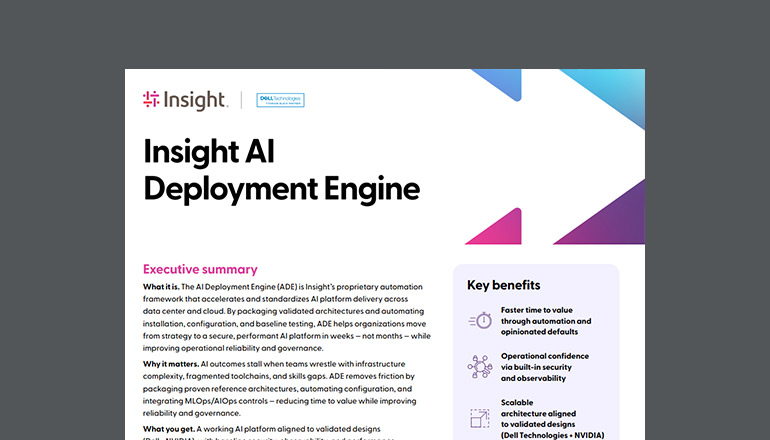Blog The AI Wild West Just Got a Sheriff: Why Your Organization Needs to Saddle Up With Model Context Protocol
By Juan Orlandini / 10 Jul 2025 / Topics: Artificial Intelligence (AI) Automation Generative AI Data protection

Ever feel like your AI tools are a bit like that super-smart friend who knows everything about one specific topic, but then stares blankly when you ask them about something outside their comfort zone?
Well, buckle up, because we’re about to introduce you to something that’s poised to turn your AI into a truly well-rounded, all-star assistant: the Model Context Protocol (MCP). Think of it as the universal translator and super-connector for your AI models.
In today’s fast-paced digital world, AI is no longer a futuristic dream; it’s a vital part of many businesses. But here’s the rub: Your AI models often live in a bit of a bubble, only knowing what they were specifically trained on.
As AI gets more sophisticated and embedded into our operations, the need for it to seamlessly connect with all the scattered pieces of information and tools across your organization becomes not just a nice-to-have, but a must-have. Ignoring this is like trying to drive a Formula 1 car on a dirt track — it might work, but you’re not reaching its full potential.
So, what’s our mission today? We’re going to dive deep into the nitty-gritty of MCP, demystifying what it is and why it’s about to become the unsung hero of your AI strategy.
Our goal is to equip you with a solid understanding of MCP. Let’s explore how MCP is set to revolutionize the AI landscape by creating a standardized, smooth highway for AI models to connect with external data and tools.
Get ready to watch your AI models go from isolated islands to a well-connected archipelago.
What is MCP?
At its core, MCP is a set of rules and standards that allows different AI models to talk to external data sources and tools in a structured, secure, and understandable way. Think of it like a universal language for AI to ask questions and get answers from the outside world.
Imagine you’re at a grand international conference. Everyone speaks different languages, right? Now, imagine there’s an amazing translator who not only translates for you but also knows exactly which expert in the room has the information you need. That’s kind of what MCP does for your AI.
MCP typically involves three key players in this communication dance:
- MCP Host: This is your AI model itself — the brainy one that needs information from the outside world. It’s like the curious student who has a question they can’t answer from their textbooks.
- MCP Client: This is the clever little messenger that sits next to your AI model. When the AI needs external data or wants to use an external tool, the MCP Client takes its request, formats it nicely according to the MCP rules, and sends it out. Think of it as the AI’s personal assistant, always ready to fetch information or deploy a tool.
- MCP Server: This is the gatekeeper and librarian of all your external data sources and tools. When the MCP Client sends a request, the MCP Server receives it, understands what the AI needs, fetches the right information from the right database, or triggers the right external tool, and sends the answer back. It’s like the central switchboard operator and information desk, connecting the AI to whatever it needs in the rest of your digital ecosystem.
Let’s make this more concrete …
Example 1: The super-smart customer service bot
Imagine you have an AI-powered customer service bot. Historically, this bot could answer questions based on its training data — FAQs, product manuals, etc. But let’s say a customer asks, “What’s the status of my order, #12345?” Without MCP, the bot would likely say, “I’m sorry, I don’t have access to real-time order information.” Not helpful, right?
With MCP, the story changes:
- The MCP Host (our customer service bot) receives the order status request.
- Its MCP Client then crafts a neat request, “Hey, MCP Server, can you please check the status of order #12345 in the ‘Order Fulfillment System’?”
- The MCP Server receives this, understands it, pings the actual order database (an external data source), retrieves the live status, and sends it back through the MCP Client to the bot.
Voila! The bot can now tell the customer, “Your order #12345 is currently in transit and expected to arrive tomorrow.” It’s like giving your bot a direct line to every department in your company.
Example 2: The data-driven marketing campaign generator
Consider an AI that helps marketing teams generate campaign ideas. Traditionally, it might come up with generic ideas. But what if it could access real-time market trends, your CRM data, and even your past campaign performance analytics?
Here’s how MCP could work in this scenario:
- The MCP Host (our marketing AI) wants to generate campaign ideas for a new product.
- Its MCP Client asks the MCP Server to fetch the latest fashion trends report from a research partner’s database as well as customer segments with high engagement for similar products from the company’s CRM.
- The MCP Server acts as the librarian, retrieving these external datasets.
The AI then uses this fresh, relevant data to churn out highly-targeted and effective campaign suggestions. For example, “Target Gen Z on TikTok with interactive short-form videos featuring eco-friendly apparel, leveraging insights from the recent trend report showing increased sustainable consumer demand.”
Suddenly, your AI isn’t just creative. It’s strategically brilliant because it’s plugged into the real world.
Why do organizations need to think about MCP?
So, why should MCP be on your organization’s radar, rather than just another tech acronym to ignore? Because it directly addresses some of the biggest headaches and missed opportunities in the current AI landscape.
Reason #1: MCP gives AI tools the power to connect to many different sources of information, making them more helpful/knowledgeable.
Imagine your AI as a highly intelligent student. Without MCP, this student only has access to a very limited library — whichever books they were explicitly given during their “training.” The student is smart, but the knowledge is constrained.
MCP, on the other hand, is like giving that student a VIP pass to the Library of Congress. Suddenly, that smart student becomes capable of tackling far more complex problems.
In the same way, MCP lets your AI pull from a vast ocean of real-time, relevant information so it can provide much richer, more nuanced insights. Your AI moves from being a specialized expert to a true polymath.
Reason #2: MCP helps secure your information as AI connects to different data sources by giving you clear control over what AI is allowed to access.
Without a structured protocol, letting AI roam free to connect to all your sensitive internal data sources can feel like handing your house keys to a very enthusiastic but potentially clumsy stranger.
You want your AI to be powerful, but you also want to sleep at night knowing your data is safe. MCP ensures that your AI only gets access to exactly what it needs, when it needs it, and through clearly defined, auditable channels. You set the rules, you grant the permissions, and MCP enforces them. This means you can leverage the power of AI with a much higher degree of confidence in your data security and compliance.
Reason #3: MCP makes it easier for developers to build new tools and apps that are compatible with multiple AIs by providing a clear set of rules for development.
Think about how frustrating it would be if every car manufacturer decided to put the steering wheel on a different side of the vehicle, or the gas pedal in a different spot. Building a new car would be a nightmare! That’s kind of what it’s like for developers building AI applications today.
Every AI model often has its unique way of wanting to connect and receive information. This fragmentation slows down innovation and increases development costs. MCP steps in as the universal “user manual” for AI communication.
By providing a standardized way for AI models to request and receive external data, developers can build tools and applications that are inherently compatible with a wider range of AI systems. This means less wasted effort, faster development cycles, and a thriving ecosystem of AI-powered solutions that can talk to each other.
How does MCP fit into the agentic AI conversation?
When we talk about “AI agents,” we're talking about AI systems designed to act semi-autonomously or autonomously to achieve specific goals. Think of them as specialized digital employees. They generally fall into three categories (note that many will span across these three “buckets”):
Category #1: Agents that augment
These agents are used to augment the capabilities of existing AI models. Using the previous analogy, the AI models you use today are like students with a limited library. These models know what they learned in training, but they have no knowledge of data that only lives in your organization.
In the past, we used things like Retrieval-Augmented Generation (RAG) to provide this additional context. With MCP, we can take advantage of a more universal process.
Category #2: Agents that automate
The next level up is agents that automate things for you. It could be business processes, or things that used to require a lot of human interaction to get done.
Imagine that your business has several vendors. Each of these vendors sends you bills in a unique format — could be PDF, email, API, etc. Today, you probably have people who know how to manage all these different systems and bills. But with automation agents, you’re able to automate these varying bill processes.
Category #3: Agents that act autonomously
This is where things get really interesting. These agents are designed to define their own goals, devise plans, execute them, and adapt their strategies based on outcomes — all without continuous human oversight.
They’re less like an employee following instructions and more like a self-starting entrepreneur. And that’s the issue.
Today we cannot and should not trust these systems with the same authority and agency that we give to humans. Ask yourself this, “Am I ready to give one of these agents the same kind of login that I give to one of my technical administration staff?” The answer’s no. We’ll get there, but we aren’t there yet.
What’s idempotency?
One of the biggest roadblocks to truly reliable, fully autonomous AI agents is something called idempotency. In simple terms, an idempotent operation can be performed multiple times without changing the result beyond the initial application. If you flip a light switch to “on,” and it’s already on, flipping it again doesn’t change anything — it’s idempotent.
Many AI models, especially large language models, lack idempotency in their actions. If you ask an AI to “write a marketing email,” and then you ask it again, you’ll get a different marketing email. There’s no guarantee of the same outcome.
This non-deterministic nature is fantastic for creativity but terrifying for critical, real-world actions. If an autonomous agent is processing a financial transaction, it needs to be idempotent. If it processes the transaction once, you don’t want it to accidentally process it again because it decided to “try another approach.”
This is why prompt engineering requires constraints.
When you “prompt” an AI, you’re essentially giving it instructions. For an AI to reliably perform a task, those instructions often need to be incredibly precise, outlining boundaries, formats, and desired outcomes. You’re trying to guide a powerful, creative, but sometimes unpredictable entity to do exactly what you want, consistently.
Without strong constraints, an AI agent could go off-script, making unintended actions that could have real-world consequences. This is where MCP becomes a game-changer for the agentic AI conversation, especially as we move toward more automated and eventually autonomous agents.
Even if an AI agent isn’t fully autonomous, it still needs to do things in the real world — whether that’s fetching data, sending an email, or updating a database. And for those “doings” to be reliable and safe, they need a structured, predictable way of interacting with external systems.
MCP provides this common pattern for AI agents to follow. Instead of each agent determining its own way of connecting to a given system, MCP sets up a standardized, secure MCP Server for all agents to use.
Why does MCP matter?
- Reliability and repeatability: By enforcing a standard communication protocol, MCP makes AI agent actions more reliable and, crucially, more repeatable. Even if the AI’s internal “thought process” isn’t idempotent, its interaction with the external world can be — thanks to the structured nature of MCP. This helps bridge the gap between creative AI outputs and consistent real-world actions.
- Safety and control: This ties back to security. As agents gain more capabilities, the ability to control what they access and how they interact with your systems becomes paramount. MCP acts as the guardrails, ensuring that even powerful agents stay within their defined operational boundaries. You want your agent to retrieve customer data, not delete it accidentally.
- Scalability and ecosystem growth: Imagine building a whole army of specialized AI agents. If each one needs its own custom integration with your enterprise systems, it’s a nightmare to manage and scale. MCP provides a unified API layer for all agents to connect, making it infinitely easier to deploy new agents, integrate them with existing systems, and even swap out AI models without having to re-engineer entire workflows.
In essence, MCP gives AI agents the structured handshake they need to interact safely and effectively with the complex world of enterprise data and tools. It’s the framework that helps us bridge the gap between AI’s immense potential and the practical, secure, and reliable operations required in a business environment.
MCP’s top benefit for organizations
And here’s the mic drop moment with one of the biggest reasons to get excited about MCP: It offers organizations a significantly more secure way to leverage AI.
Remember that common worry about feeding all your sensitive, proprietary enterprise data into a large AI model for training? That can be a valid concern for data privacy and intellectual property.
MCP beautifully sidesteps this issue. Instead of training AI models on your sensitive enterprise data (which can be risky and expensive), MCP allows the AI model to query your data sources in real time, on demand, and under strict access controls.
Think of it like this: Instead of sending all your valuable family heirlooms to a new art appraiser to learn about them (and risk them getting lost or copied), you invite the appraiser to your home, where they can examine the heirlooms under your supervision, making notes as needed, and then leave without ever taking possession of your precious items.
MCP provides that secure, supervised access. Your AI gets the context it needs, without your critical enterprise data ever needing to be ingested or “baked into” the AI model itself.
In a world where AI is rapidly becoming indispensable, MCP is the sensible, secure, and smart way to unlock its full potential within your organization. It’s time to stop letting your AI live on an isolated island and connect it to the mainland of your enterprise with MCP.




